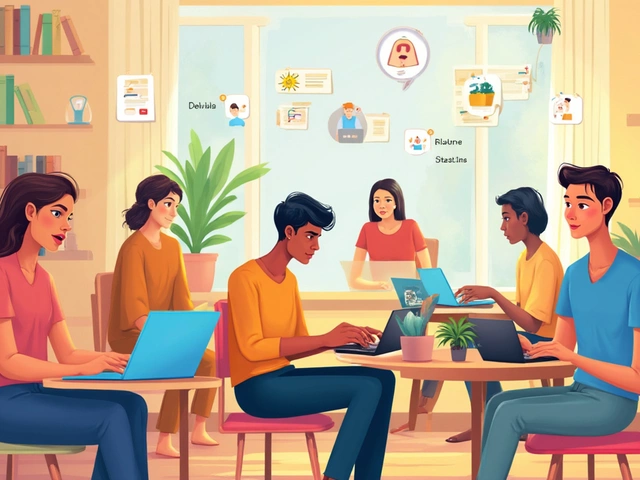
If you check your phone right now, chances are you've got at least three different apps open: maybe a messaging app, a shopping app, or a site to watch videos. But have you ever thought about what these apps really are under the hood? They're all examples of online platforms. These platforms basically run daily life now. Shopping, learning, sharing moments, running businesses—nearly everything clicks back to some platform. What's wild is that while we use tons of these platforms, most people don't have a clue how to separate them in their minds. Let's break it down and make it clear (finally!) what types of online platforms exist, why they matter, and what sets them apart.
Social Media Platforms: The Virtual Town Squares
Scroll through Instagram, post on Facebook, send a snap on Snapchat—these aren't just fun distractions, they're examples of social media platforms. Think of them as digital spaces where people hang out, chat, share updates, and connect with each other in ways that weren't possible twenty years ago. Social media platforms exploded in popularity for one simple reason: people love talking to each other, even if they're miles apart. Platforms like Instagram, Facebook, Twitter (X), and TikTok pull in billions of users because they let us share a slice of our lives instantly. It's more than just cat memes and vacation photos, though. These platforms have created jobs, made influencers out of regular people, and even helped movements gain steam—remember the Ice Bucket Challenge? That grew legs on social media.
But how do these platforms actually work? At their core, they're built to connect users using profiles, feeds, chat functions, and instant notifications. Algorithms decide what you see, based on what you engage with. That's why if you like a few dog videos, suddenly your feed is all puppies all the time. This can be helpful—like when you want to find your old classmates or stay updated on breaking news. It can also feel a bit creepy at times, if we're honest. A Pew Research study from 2023 found that over 70% of teens in the US felt they couldn't imagine life without social media. That's a double-edged sword: while platforms offer support and humor, experts warn about issues like online bullying and addiction.
For businesses, social platforms are gold mines for marketing. Brands know that the fastest way to catch your eye is in the feed you're scrolling. Influencers—regular users who gain massive followings—can launch brands or shut them down with a single review. Social media is now the backbone of viral trends and digital activism. Remember when #BlackLivesMatter took over the internet? That started and spread thanks to these platforms.
"Social media platforms have rewired the way societies stay informed, spread ideas, and mobilize for causes." — The New York Times, 2024
If you're worried about privacy, know this: almost every social platform collects your data. Read those privacy policies, or at least use strong passwords and tweak your settings for maximum control. And always watch out for scams—if a "friend" sends you a suspicious link, it might not really be them.
Tips if you're building your own social platform? Start small. Figure out what community you're targeting. Success comes from having a clear focus—TikTok, for instance, zeroed in on short, fun videos and grew crazy fast as a result. If it feels like every new trend starts and ends with social media, you’re not wrong. These platforms are the engines behind viral videos, challenges, and sometimes global conversations. Whether you love them, hate them, or just zone out to scrolling, you can't ignore how social media changed how we interact with the world.
Educational Platforms: Online Classrooms and Beyond
If someone told you ten years ago that kids and adults could earn degrees, upskill, or even prep for medical or law exams—all without stepping into a physical classroom—you might have laughed. Fast forward to today, and online learning is everywhere. Educational platforms are the real gamechangers here. They’re not just for students; they’re for anyone who wants to learn at their own pace from anywhere. Whether it's Khan Academy, Coursera, Udemy, or language-learning apps like Duolingo, these platforms put world-class lessons right in your pocket.
What makes them tick? At the heart, it's the content—videos, lectures, quizzes, assignments—organized so users can learn step-by-step. Most platforms let you track your progress, earn certificates, and even join discussion groups. Some, like Udemy, allow anyone with expertise to upload and sell their courses, while others, like Coursera, partner with top universities to deliver recognized programs. According to UNESCO, the number of students using online learning platforms doubled between 2020 and 2024. This rush wasn’t just because of the pandemic—people are craving flexibility, and employers are valuing verified online credentials more than ever.
There's more than just academic content. Platforms now cover anything: playing guitar, coding Python, prepping for the SATs, learning soft skills like public speaking. Many companies are using "Learning Management Systems" (LMS) to keep employees sharp and drive professional development. And adaptive-learning features—fancy talk for platforms that adjust the lesson difficulty based on your answers—mean learning online can be just as personal as a real classroom.
One big fact: more students in India now use online test prep services than all the brick-and-mortar coaching centers combined for government and competitive exams. E-learning has exploded in places where traditional education resources fell short. If you've ever wondered why a friend aced a tricky exam, odds are they caught up with a few crash courses online.
If you’re worried about getting lost or left behind, most platforms have built-in support. Forums, live help, direct messaging with instructors—just like raising your hand in class. But here's a pro tip: set a schedule and stick to it. It's way too easy to "watch later" yourself into never finishing a course. And don’t be afraid to try something new—dabble in coding, learn a language, pick up photography. You never know what new hobbies (or careers) might spark.
The future? AI tutors that adapt to whatever style suits you best, classes in virtual reality, and personalized learning paths that can help you go from beginner to pro in record time. If you’re not taking advantage of some form of online learning, you might be missing out. The best part: much of it is free or super affordable compared to traditional tuition.

E-commerce Platforms: The Digital Malls in Your Pocket
Remember when you needed to go downtown or across the city just to shop for anything? Now you can buy a phone, groceries, or even a car from your couch—thanks to e-commerce platforms. These are the giants like Amazon, Flipkart, eBay, Etsy, and Shopify, reshaping how we buy and sell pretty much everything. It’s not just retailers, either; regular folks can sell secondhand goods or launch a business without renting a shop. E-commerce platforms bring buyers and sellers together on one secure, convenient website or app.
So, what powers them? First, there’s the giant catalog of goods—they make it easy to browse everything from shirts to laptops in seconds. Then there’s a safe payment gateway, allowing you to pay instantly (sometimes even with one click). Even more, built-in tracking and review systems help keep everyone honest. Amazon, for example, prides itself on being "Earth’s most customer-centric company", shown by return policies and two-day shipping. Their model works: as of 2024, global online retail sales topped $6.5 trillion, with Amazon leading more than 35% of that.
Beyond Amazon and its kin, specialized platforms have popped up everywhere. Etsy is famous for handmade crafts. StockX for sneakers. Grofers for groceries. Even car sites like Carvana let you buy and get a car delivered without ever seeing a dealer in person. Have a skill for making something cool? Marketplaces allow you to start selling in minutes, skipping all the headaches of renting a stall or storefront. During the 2022-2024 period, the biggest e-commerce growth actually happened in “social commerce”—where people buy products straight off Instagram, WhatsApp, or TikTok.
Mobile shopping is a huge deal. Most young shoppers these days browse and buy from their phones, not computers. That’s pushed platforms to focus on quick, clean experiences—a couple swipes, an address autofilled, and you’re done. But don’t forget about security: always use official apps, avoid public Wi-Fi for payments, and double-check ratings before entering your card details. Scams do exist, so if it sounds too good to be true, it usually is.
E-commerce also flips the script for small businesses. You can reach customers not just in your neighborhood, but around the world. Tools like Shopify, with easy templates, make it simple for anyone to launch an online store. Many young entrepreneurs have started whole brands during the pandemic, never owning a physical shop. Just keep your eyes peeled for platform fees, and always read the fine print before signing up.
Feeling overwhelmed by unlimited choice? Tips: use filters for what you really want, check return policies carefully, and always read plenty of reviews. Some items might look great in the photo, but reviews help separate real gems from duds.
How to Choose the Right Platform for Your Needs
With all these platforms towering over the digital landscape, picking the right one can be tricky. Maybe you’re looking to build a business, share your creativity, find your crew, or learn something new. Each platform type has its own strengths. Social platforms work best for growing an audience or staying in the loop. E-commerce platforms are your go-to for buying and selling. Educational ones are perfect for building knowledge or prepping for exams.
Not all platforms are made equal, though. Facebook might be a bad fit if your main goal is private collaboration—try Slack or Discord instead. Amazon is great for wide reach, but selling unique, one-of-a-kind products might be better on Etsy. If you want a structured course from a university professor, Coursera or edX are smarter choices compared to YouTube’s ocean of self-uploaded content.
A clever way to get more out of platforms is blending them. You could learn guitar with video courses (educational), share your progress on Instagram (social), and eventually sell custom picks or tabs on Etsy (e-commerce). Pretty soon you’ve turned a hobby into income, with only a smartphone and some wifi.
Here’s a quick breakdown for choosing:
- Social Media: Best for building communities, personal branding, or launching viral campaigns. Recommended for creators, activists, and anyone eager to connect instantly.
- Educational: Great for structured learning, certifications, and upskilling. Fits students, professionals, or curious lifelong learners.
- E-commerce: Your ideal choice for selling goods or services, reaching a wider market, and managing online transactions. Entrepreneurs and small businesses thrive here.
Sometimes you’ll jump between all three. An educator might post tips on Twitter, sell e-books on Shopify, and teach live classes on Zoom. Pick what works for your goals, experiment, and be prepared to learn as you go. Platforms will keep evolving, and new types will show up, but these three—social, educational, and e-commerce—are the main building blocks of life online right now. They aren’t just trends. They’re the foundation of a connected world.





